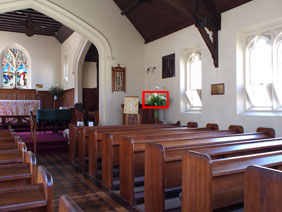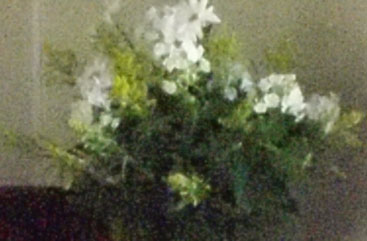Olympus ‘PEN’ E-P2
-
-
Written by Gordon Laing
Olympus E-P2 vs Nikon D90 High ISO RAW Noise - files processed for similar style
Olympus E-P2 results : Real-life resolution / High ISO JPEG Noise / High ISO RAW Noise / M.Zuiko Digital 17mm lens sharpness
Olympus E-P2 results : Real-life resolution / High ISO JPEG Noise / High ISO RAW Noise / M.Zuiko Digital 17mm lens sharpness
|
 | To compare noise levels under real-life conditions we shot this scene with the Olympus E-P2 and Nikon D90 within a few moments of each other using each of their ISO settings. The E-P2 was fitted with the M.Zuiko Digital 17mm kit lens and the D90 with the DX 18-105mm kit lens, the latter adjusted to match the vertical field of view. Each shot was taken in Aperture Priority with Auto White Balance. For this page we processed RAW files with the supplied software to deliver similar levels of sharpness, contrast and saturation. See in-camera results in our High ISO JPEG Noise page. |
The image above was taken with the Olympus E-P2 in Aperture Priority mode at 17mm f5.6 with a sensitivity of 100 ISO. The original RAW file measured 11.7MB. The exposure as metered by the E-P2 was 0.77 seconds. The same exposure at f8 and 100 ISO on the D90 would have required a shutter speed of 1.5 seconds, but as described on the previous page, this delivered an image that was brighter and over-exposed. In order to match the E-P2’s middle-grey brightness required an exposure of one second at 100 ISO f8 on the D90, which coincidentally was what the camera metered without compensation. This does however mean the D90 was again operating at around a 2/3 EV difference.
The crops are taken from the area marked with the red rectangle and presented below at 100%. Note the Nikon D90 captures wider 3:2 aspect ratio images, so by matching the vertical field of view, we’re effectively treating the DSLR here as a 10.8 Megapixel camera, delivering 4:3 shaped images. As such, the D90’s crops show a slightly larger area due to its lower vertical resolution.
Our goal here was to better match the style of each camera’s output in terms of white balance, sharpness, contrast and saturation for a more level playing field. We adjusted these parameters using each camera’s supplied RAW processing software: Olympus Master 2.3 for the E-P2 and Nikon Capture NX 2.2.3 for the D90.
Starting with the default values, we set the sharpness to -1 on the E-P2 to tone it down a little. Interestingly the default settings for the D90 RAW files delivered crisper and punchier output than its JPEGs, so we kept the sharpening at 3 to match the Olympus. We did however need to reduce both the contrast and saturation to -1, while additionally tweaking the white balance for the same neutral middle-grey value. The coarseness of these settings, not to mention the differences in the actual cameras themselves meant we couldn’t achieve a perfect match – for example the D90’s output below is sharper, but turning it down or increasing the Olympus by a notch delivered a bigger difference. We hope you agree they’re a much closer match than the in-camera JPEGs on the previous page though.
With the sharpening toned down on the E-P2, its noise levels become much more discreet in the 100 to 400 ISO range. Conversely a boost in sharpening on the D90 makes its noise textures more obvious. This adjustment has actually brought both cameras pretty close in style and visible noise levels, although again the D90’s higher dynamic range coupled with a shorter overall exposure (to match middle-grey brightness) has allowed it to retain greater highlight detail in the white flower petals. Some of these have become irretrievably saturated on the E-P2.
At 800 ISO and above, the story remains pretty much the same as the in-camera JPEGs. The E-P2 takes a hit at 800 ISO, with a noticeable fall in sharpness and fine detail. Admittedly noise levels with the sharpening turned down here don’t become too obtrusive until higher sensitivities, but the fact is the D90 comfortably out-performs it at 800 ISO and above. You’ll also notice even though we roughly matched the colour balance at 100 ISO, the E-P2 shifted at higher sensitivities.
What this test has proven though is toning down the default processing can greatly reduce visible noise levels on the E-P2, and between 100 and 400 ISO it can compete pretty confidently against one of the best DSLRs in its class. At 800 ISO and above though, the E-P2 suffers in comparison whether you’re shooting JPEG or RAW. But again the output is much preferable to conventional compacts, which even at 200 ISO are struggling.
The bottom line is the E-P2 delivers true DSLR quality between 100 and 400 ISO, but for the best results try to avoid 800 ISO and above, and be careful with exposures to protect highlight areas if necessary.
For more real-life images taken throughout the E-P2’s sensitivity range, check out our E-P2 Sample Images Gallery. Alternatively if you’d like to see how the pancake kit lens performs at different apertures, check out our M.Zuiko Digital 17mm 2.8 test report.
Olympus E-P2: RAW with Olympus M.Zuiko Digital 17mm f2.8 |
Nikon D90: RAW with Nikkor DX 18-105mm VR | |
 |  | |
100 ISO |
L1.0 (100 ISO) | |
 |  | |
200 ISO |
200 ISO | |
 |  | |
400 ISO |
400 ISO | |
 |  | |
800 ISO |
800 ISO | |
 |  | |
1600 ISO |
1600 ISO | |
 |  | |
3200 ISO |
3200 ISO | |
 |  | |
6400 ISO |
H1.0 (6400 ISO) |





